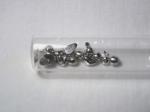


Left to right : Tin, Tin, Tintin
Monday, August the 22nd, 2005
back to: title, date or indexes
This week's Hooting Yard Metal of the Week is tin.
Many words rhyme with tin, such as bin, din, sin, gin, Rumpelstiltskin, and pin. For this reason, it is quite easy to make up verses about tin. Harder, though, to ensure that those verses have something arresting, urgent and original to say, especially about tin, if it is the main subject of the poem. Let us imagine that you have been commissioned by a maker of calico prints to sing the praises of tin chloride as a reducing agent and as a mordant. I doubt very much that you would be able to dash off a suitable poem just by listing the words that rhyme with tin. But perhaps you are more accomplished as a poet than I am.
In his pamphlet Astrochemistry : A Study of Metal-Planet Affinities (Emergence Press, 1984), Nick Kollerstrom writes Tin is the one metal of the seven which does not show much evidence of its planet's signature. I asked an astrologer about this and he replied: ‘Why, how could it? The Jupiter attributes—expansion, joviality, wisdom—how could a metal express these?’ How indeed? It seems that with tin we have to be content with only a very partial expression of the planet traditionally associated with it. Mr Kollerstrom does not explain how a big lump of rock, metallic hydrogen, liquid hydrogen, and gaseous hydrogen orbiting the sun millions of miles away “expresses” expansion, joviality, and wisdom, but I am sure he knows what he is talking about, because he makes a point of stressing that he is an MA Cantab, and thus no ordinary mortal.
Dobson was no ordinary mortal either, for different reasons. As one might expect, he turned his attentions to tin on a number of occasions, chiefly in the pamphlet he called simply Tin Book. He set himself the task of mentioning tin once on the first page, twice on the second page, and so on until the final page included forty-four mentions of the silvery, malleable poor metal that is not easily oxidized in air and resists corrosion. This leads to somewhat idiotic passages such as this, from page ten:
I stood on the mountainside in the rain. There was a crow perched on my head, and its talons clawed at my scalp, but I had swallowed an anti-crow-clawing-pain pill an hour earlier. I peered into the rain-sodden gloom until I could make out the weather vane in the far distance. Conditions were perfect for the Shouting The Names Of Metals At The Sky experiment. “Tin!” I yelled, “Tin tin tin tin tin tin tin tin tin!”
Dobsonian scholars have got themselves into something of a tizz arguing whether the out-of-print pamphleteer is describing actual events in Tin Book, or just making them up. My own view is that it hardly matters.
To end this fascinating look at our Metal of the Week, try to lodge the following fact in your cranium. At low temperatures, tin exists as gray or alpha tin, which has a cubic crystal structure similar to silicon. When warmed above 13.2 °C it changes into white or beta tin, which is metallic and has a tetragonal structure. Alpha tin ought not be confused with the Alpha Course, created by Nicky Gumbel, which propounds a reductive and distorted version of Christianity, nor with Alpha males. Dobson, by the way, once described himself as an Epsilon male, but quite what he meant by that is far from clear.



Left to right : Tin, Tin, Tintin
Hooting Yard on the Air, September the 7th, 2005 : “Horse Begone” (starts around 23:52)